How to Build a SaaS Product: Comprehensive Guide
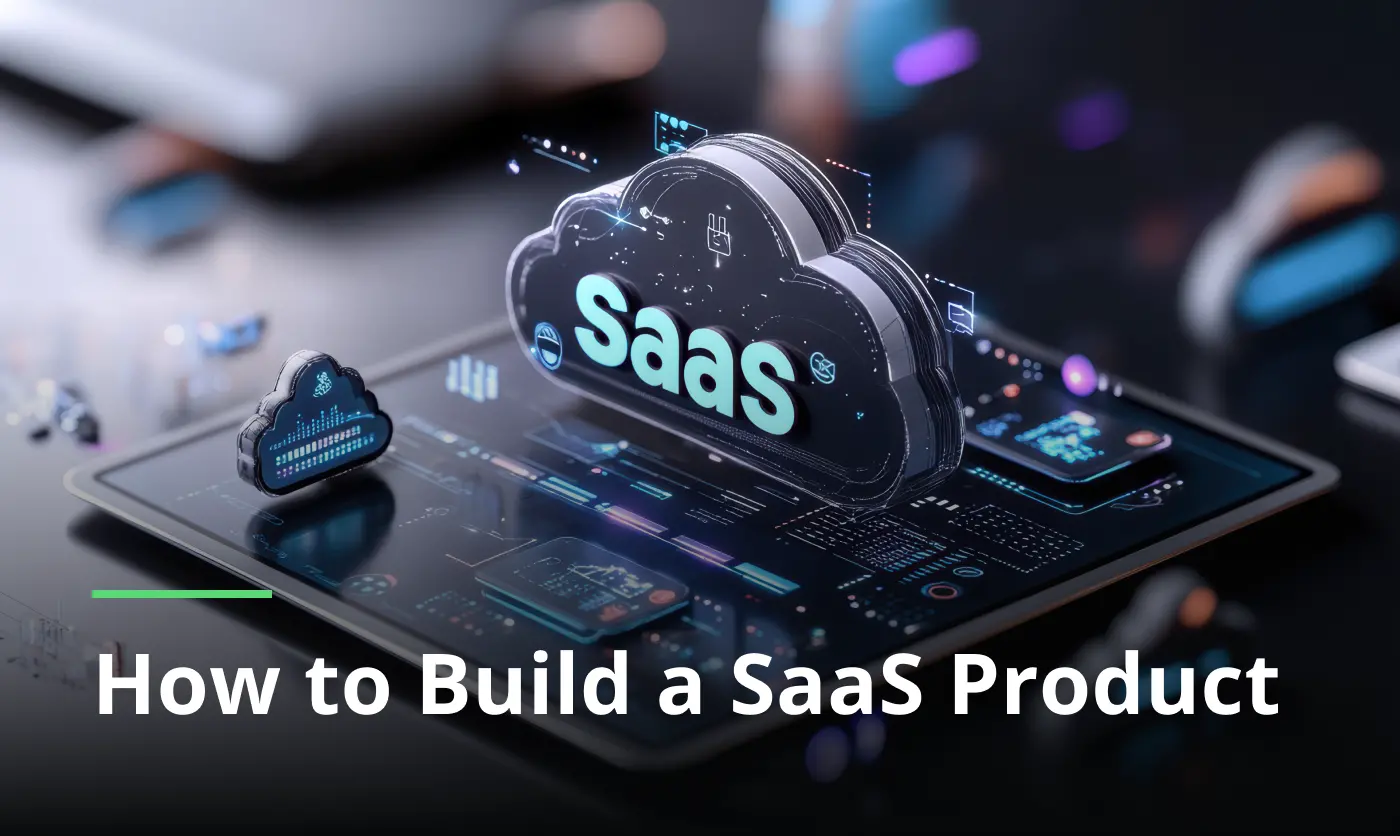
Trying to learn about SaaS product development for business owners can feel like sweating bullets in a snowstorm. As it is a significant investment, you definitely want to receive practical and actionable insights about how it can impact your company. Our guide about Software as a Service provides more than just theoretical information; it gives a breakdown of every aspect of this theme.
With a strategic roadmap, you are capable of building a SaaS product that will become cost-effective, meet genuine objectives, and drive more value for your firm. You will get familiarized with software products you are able to create, how much it costs, what technologies to use, terms, trends, and more.
As a vendor with experience in software development services, we know how challenging it is to build a SaaS system without a clear road, so you will read about our background and in-depth insights. Let’s reveal the nitty-gritty behind product development for SaaS and define how you can succeed with such an innovation-driven model.
What is SaaS product development?
SaaS stands for “Software as a Service” when you are paying for access to a solution online (based on a subscription model), instead of downloading it to your device. As a business owner, you may hear about management tools like Slack which is a cloud-based platform that takes recurring fees for its services.
Therefore, you are using it, paying for it, and the provider engages in maintenance so that customers receive the latest version of the software and get issues solved in a short time.
The custom SaaS product development covers the end-to-end creation process, from evaluating the idea to coding, designing and deploying. Further in this material we, as a SaaS product development company, will consider the actionable stages for you to know where to start with such a product building.
What types of SaaS can you receive? — the most common one is CRM like Salesforce that assists firms on managing their interactions with clients, as well as ERP, financial solutions like Stripe, and more.
For now, as you are aware of the brass tacks of this process, let’s move on to the actual steps of the crafting system that will deliver you more benefits and fulfill business objectives.
How to create a SaaS product in 5 steps?
Even with the greatest idea on your mind, without a proper understanding of the solution-building process, your investment can go down the drain. We will walk you through each stage, and the labyrinth of SaaS will turn into a straight corridor once you finish this article.
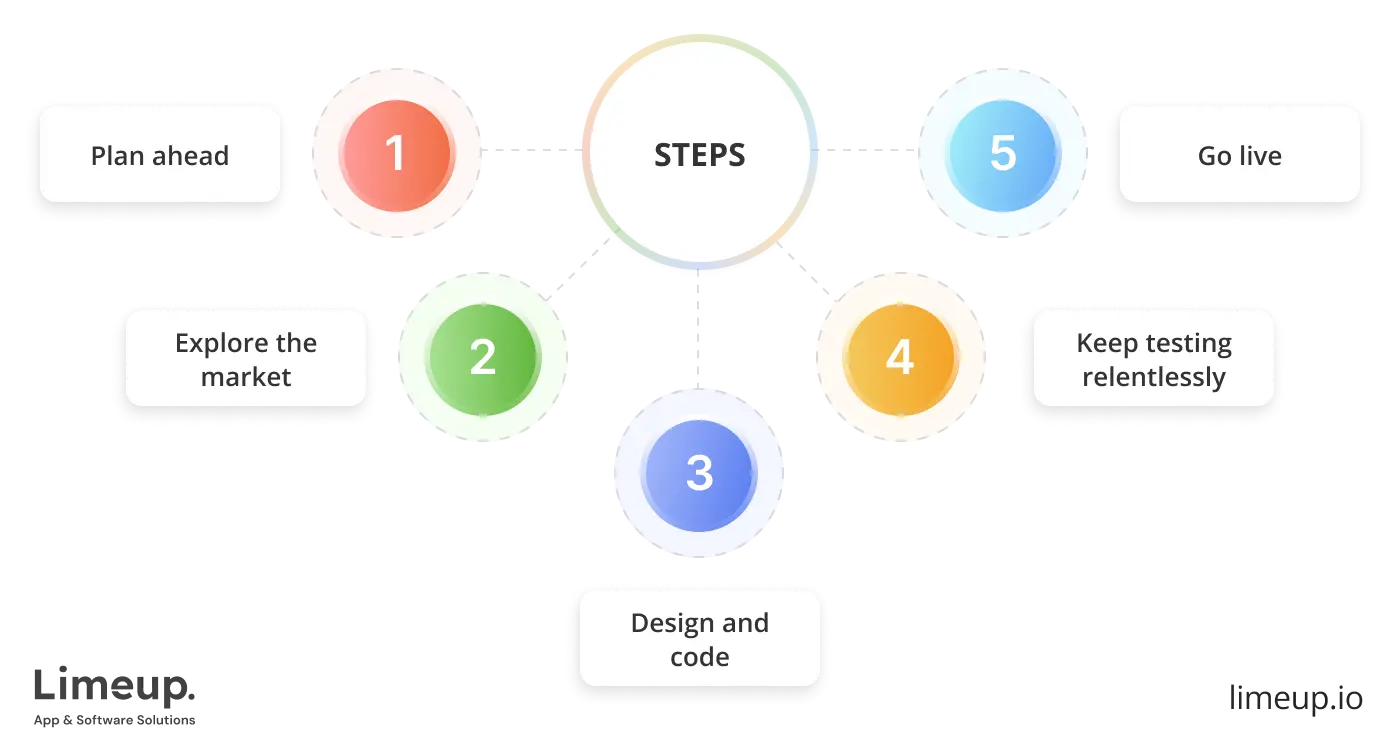
— Step 1. Do your planning homework.
SaaS product development starts with understanding your tech journey, beginning with a simple “Why?” that helps you define the core goal of the future project. Ask yourself, if your purpose is about:
- automation of internal processes,
- streamlining management,
- creating a new revenue stream,
- serve a specific market need,
- renovate the outdated system, etc.
When you find issues that are worth solving and answer why you and your clients need it, it is time to take a look at the next phase.
— Step 2. Discover the market, competitors, and more.
You are here to resolve real problems and not just build a software that will exist and not drive your growth, that is why defining the current market state, niche statement, trends, challenges, contenders, their strong sides, what they offer and how they attract users.
Therefore, you will receive multiple perspectives and will be able to answer “What is happening?” and bring the structure to a chaos of when you have a brilliant idea but have no clue about how to make it a reality.
— Step 3. Design and code.
Here is where SaaS-based product development begins, and our experts turn the whole point of this stage into three words: making your solution simple, clean, and appealing. As for the UI/UX design, you have to ensure that the interaction with your audience is flawless, as it is better for them to spend less on defining where to click to receive what they need.
You can learn the programming languages required for this creation, as well as libraries, frameworks, and other technologies, or you can cooperate with development teams, for example, with a custom software development company in the UK that knows how to develop a SaaS product and has reliable experience.
It is also preferable to build an MVP (Minimum Viable Product) as it is the quickest and most cost-effective way to test your idea and determine if the game is worth the investment. You are capable of receiving general feedback from end-users who get your solution into their hands, use it, break it, define pain points.
— Step 4. Test, then test, and test some more.
You are going to present this product to your clients, and the core moment is to ensure it performs well in every aspect. There are a bunch of videos revealing the topic if it is OK to go live without testing, and it can be a good point but the risk is high.
Here, you can apply automated and manual testing, with your programmers who become quality assurance experts and your beta users who can tell if the feature works properly, or you can also implement AI-powered tools that are rapidly evolving nowadays.
— Step 5. Go live (simply yet nuanced).
You have gone a long way from a decision to build a SaaS product to actually launching it and introducing it to your niche. As you ensured it performs according to expectations, it is time to be online and gather the first feedback from customers.
Here, you will continue working on your system as there is a past-launch phase that ends only when your solution is no longer available: you need to monitor bugs, solve them, update security patches and add features, remove the outdated ones, expand the target audience, and more.
You are armed with all the information required for a successful development of a SaaS platform, and here is more for you to be aware of, so let’s skip talking about this point and delve deeper into the demand details.
What are the core features for building a SaaS product?
The functions you select are the tangible representations of your SaaS-related concept, and starting the building without knowing what to create is like navigating through dark and risky waters, only to find out there is a storm.
You will be able to prevent possible failure by learning what essential functionality is needed for your project to fulfill your customer requirements, differentiate yourself in the cut-throat market, for example, the fintech, allocate available resources, work on a monetization strategy, and more.
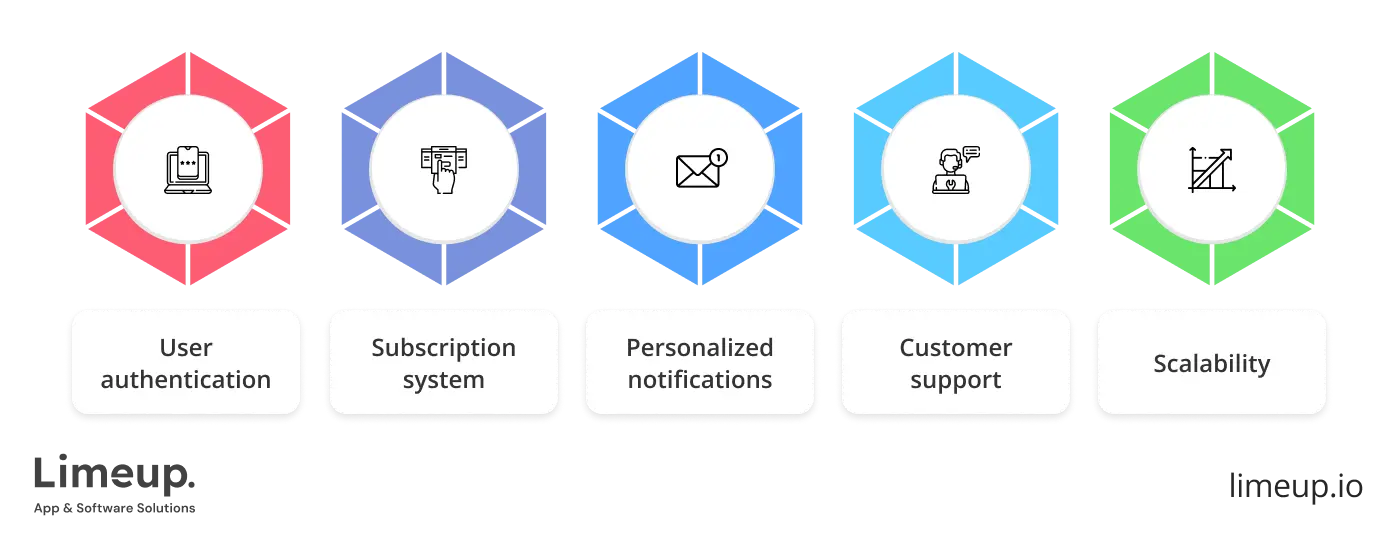
Here are the 5 core features you can build regardless of your niche:
-
User authentication is the first thing our developers named when we asked them about essentials for a SaaS platform, and there is no wonder why, as for a secure one, it is a combination of various security practices and management of sessions, enhanced control, and more.
Here, you need to define which method suits your users’ needs: email and password, SSO (Single Sign-On), ability to log in using a Google account or LinkedIn/Instagram/Facebook, phone number, and many others.
-
The subscription system is not only about the amount of money you would like to receive for your services, but also which tool you will use for integration — Stripe, PayPal, Maxio or else. Then, you will select if you want to add automation to payments, how you will manage all the subscriptions, and more.
Therefore, you will create a SaaS product that 100% meets your requirements in billing model, analytics, invoices history, etc.
-
Personalized notifications are part of a trend we will reveal more in this article, and they provide engaging activities to make users come back to your system and simultaneously prevent errors.
For instance, our recommendation is to consider notifications for security, billing reminders, mentions, system, and others. Let’s say that you run a fintech firm that offers investing services, and you store a lot of personal information that it is better not to be accessed by third parties.
In this case, you are able to find dedicated software engineers who can build feature to notify customers about new log-ins from suspicious devices and enable multifactor authentication to build more trust from the user side and ensure the data is protected.
-
Customer support has to be included when you make a SaaS product whether you are a logistics firm or eCommerce brand, as this function is about your clients and how you serve their needs. It is all about fast replies and feedback from end-users so that you can make this feature better.
Define what is required for high-quality help through chatbot, contact form, FAQs, or others. Here, you will get a lot of help from your target audience analysis as you will know what aspects of support they want to receive.
-
Scalability is required for businesses that need to scale up their capabilities across various areas: handle more online users so that the system will not crash, meet specific demands, and so on.
For example, Netflix has over 200 million subscribers, and in days of global premieres, it has to ensure that every user will be able to access the series without errors, and that is where scalability comes into play to help them.
While creating a SaaS product, you will be able to prioritize the must-have and nice-to-have, and also remain flexible to adapt to current market needs. Additional functions depend on the type of platform you want to receive, as well as on nuances like industry demands, clients’ pain points to be covered, and more.
At once, let’s determine the technologies you need to use to build a system and how they impact your project.
What tech stack is used for SaaS product development?
To make it clear, not everyone has to be a tech-savvy person, and many business owners are looking for clarity and practicality through the topic of technology. Our experts prepared a brief yet comprehensive review of programming languages, tools, and others for you to make a well-informed decision and be able to evaluate software providers if you decide to cooperate with one of them.
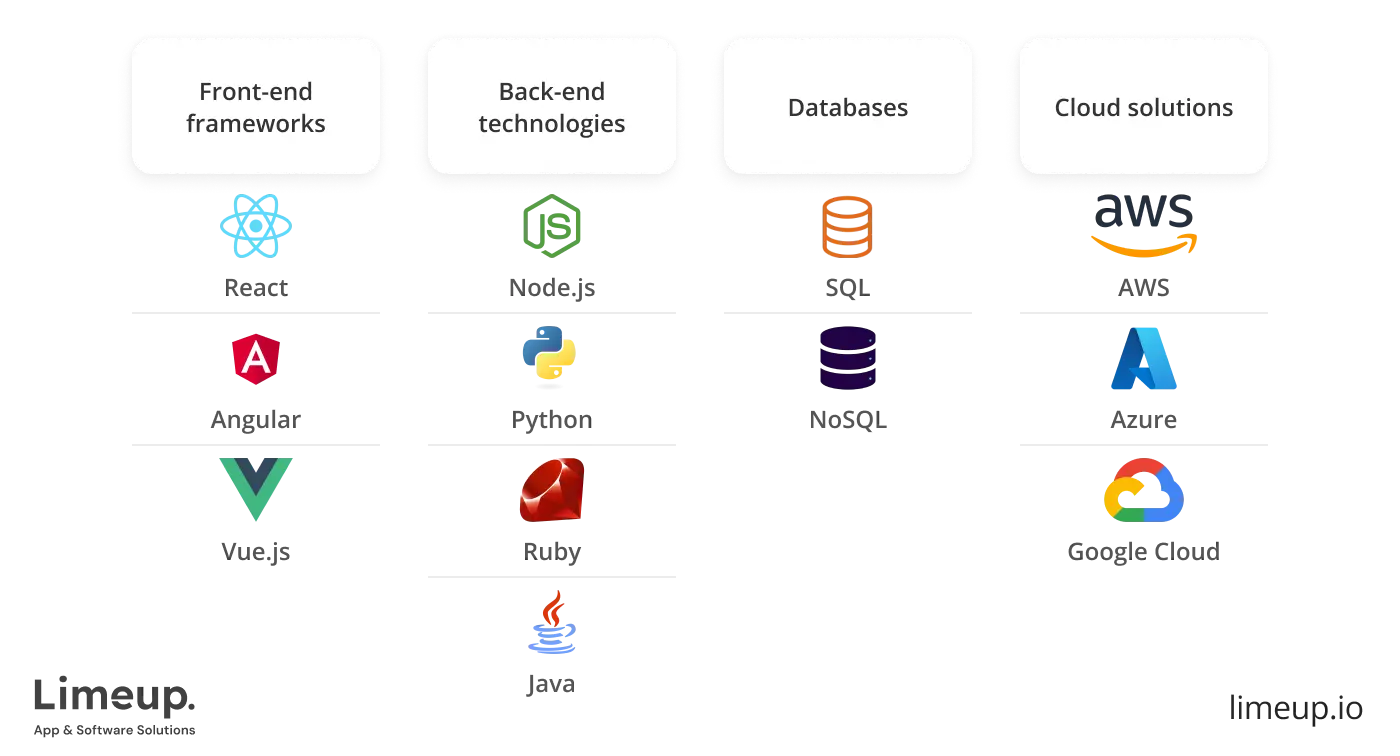
Let’s focus on “what it does” and “why you need it” instead of explaining the actual coding process. We will consider the foundation, visual part, cloud computing, and more.
-
Front-end frameworks stand for every element your end-users interact with — you have to ensure they will be satisfied and pleasant, finding your solution intuitive to navigate. Based on our experience as a SaaS product development company, it is essential to make your software gratifying, but how to accomplish it?
With the usage of React, Angular, and Vue.js for dynamic elements that are able to be clicked, moved, or else. As for the display, you definitely heard about HTML and CSS. At least everyone who tried to code once was writing “Hello World” using this language and styling it.
-
Back-end technologies are the hard workers here, as they build everything that front-end and designers imagined for your solution. In other words, you can do only the first part and it will be beautiful yet useless as the back-end holds the skeleton and then you can build muscles (your visual parts) around it.
Typically, Node.js, Python, Ruby, and Java are used to build the logic, which is literally the “brain,” processing signals to determine what needs to be done when users click on buttons or type text.
-
Databases are responsible for data storage, where you keep information about your customers, system, and so on. Across two predominant SQL and NoSQL commonly used when you decide to build a SaaS product according to your purpose.
For instance, SQL is a common choice for builders with complex projects with structured data, while NoSQL is a top-tier variant for flexibility and unstructured data.
-
Cloud solutions are the backbone of Software as a Service used in various cases, for instance, it is aimed at more scalability and better performance. The most in-demand platforms include AWS which brings to the table beneficial moments like global scale and better compliance.
There is also Azure powered by Microsoft, with a robust toolkit for SaaS, and Google Cloud which incorporates AI for this service, making solutions “smart, simple, secure, scalable.”
All the technologies are widely used in making a SaaS product and your choice depends on the needs you will define. Your strategic decision defines how the creation phase will go, so it is advisable to take time and decide on teams you will involve, their capabilities in technologies.
How much do SaaS product development services cost?
A full estimation can be done after you contact a provider and define your demands so that you can count the scope of work, technologies, the number of team members, and other factors.
Still, our specialists do not want to leave you without the answer, so based on their experience, you typically have to pay $5,000–$150,000+. It seems like a large gap, and you are right, it is because of the thing we noted — the final price will be defined when you decide on:
- team’s location,
- type of SaaS platform,
- features,
- infrastructure,
- integrations, etc.
Here is a simple table that describes the price for a software that can be built by SaaS product developers:
| Type | ~$ | Review |
| MVP | ~$5,000 | You can work on your own or hire a solo IT guru who will build a minimum product with core functions. |
| Simple SaaS | $20,000–$49,999 | It can be handled by a small and mid-sized crew of coders who build a dashboard, all the basic tools, APIs, and implement payment options. |
| Mid-sized | $50,000–$149,999 | Here, you need a full-scale group of tech wizards with experience of crafting platforms like yours. |
| Enterprise | $150,000+ | Such a complex project requires not only programmers but QA experts, DevOps, UI/UX designers, and more people as you receive rich features powered by AI and other technologies. |
As we have defined the cost for different kinds of such sites, let’s move on to the option of hiring IT suppliers worldwide, and what their rates are according to the most popular hunting platforms and their levels.
Rates for SaaS product development experts
Here, you will see a brief description of how much coders charge according to their knowledge and background as well as core moments like location, it is the first standpoint defining their hourly prices:
| Level (years) | Hourly $ |
| Junior (up to 2) | $20–$49 |
| Middle (2–5) | $50–$99 |
| Senior (5+) | $100+ |
You are able to select the one that fits your budget and needs, and it is also essential to point out that you can always contact SaaS product development experts and agree on a price that is suitable for both of you.
Hidden costs to consider
Since building such a solution is not a walk in the park, it is preferable to be aware of tricky moments you can meet when defining how much you will spend on a project. First of all, it is about ongoing maintenance that typically costs around 20% of the initial development, yet it is not always written in a contract so you can clarify this point.
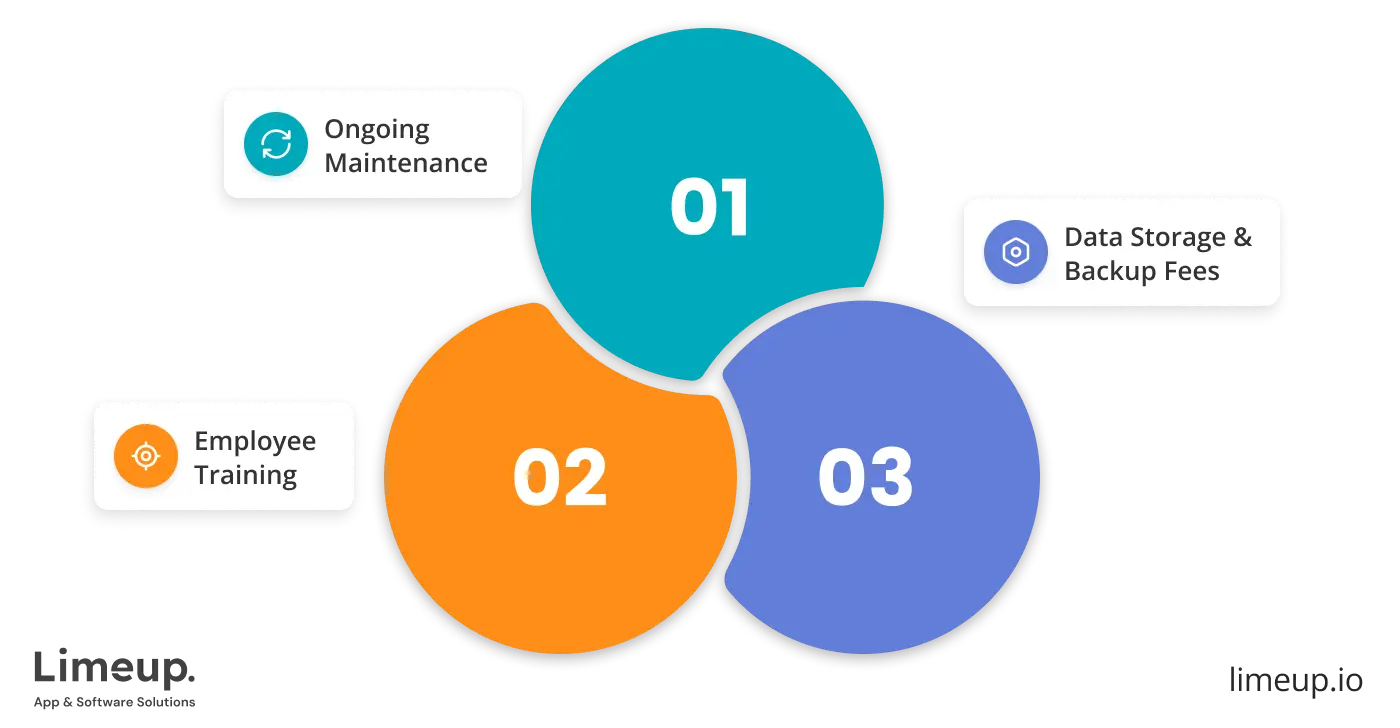
Secondly, it is about your employees’ training if they are newbies to this tech stuff, and they will operate with SaaS platform to manage customers, gain data, analyze it, and so on. Thirdly, pay attention to the charge for information storage as sometimes you may pay additionally for backup, migration, and so on.
What is the typical timeline for developing a SaaS product?
An arduous SaaS platform creation can not be built in one day, even an MVP we noted above, which takes up to 4 months to be made. As for the full-fledged development, you need to dedicate from 8 to 12+ months.
Searching on this theme, we found some videos where coders and non-tech persons tried to make SaaS products in 1, 100, 300 days, and the main idea our experts received was about not doing hard and focusing on your goals.
Here, you will learn more about factors that impact the duration of developing a SaaS product and how much time and effort are required for each stage:
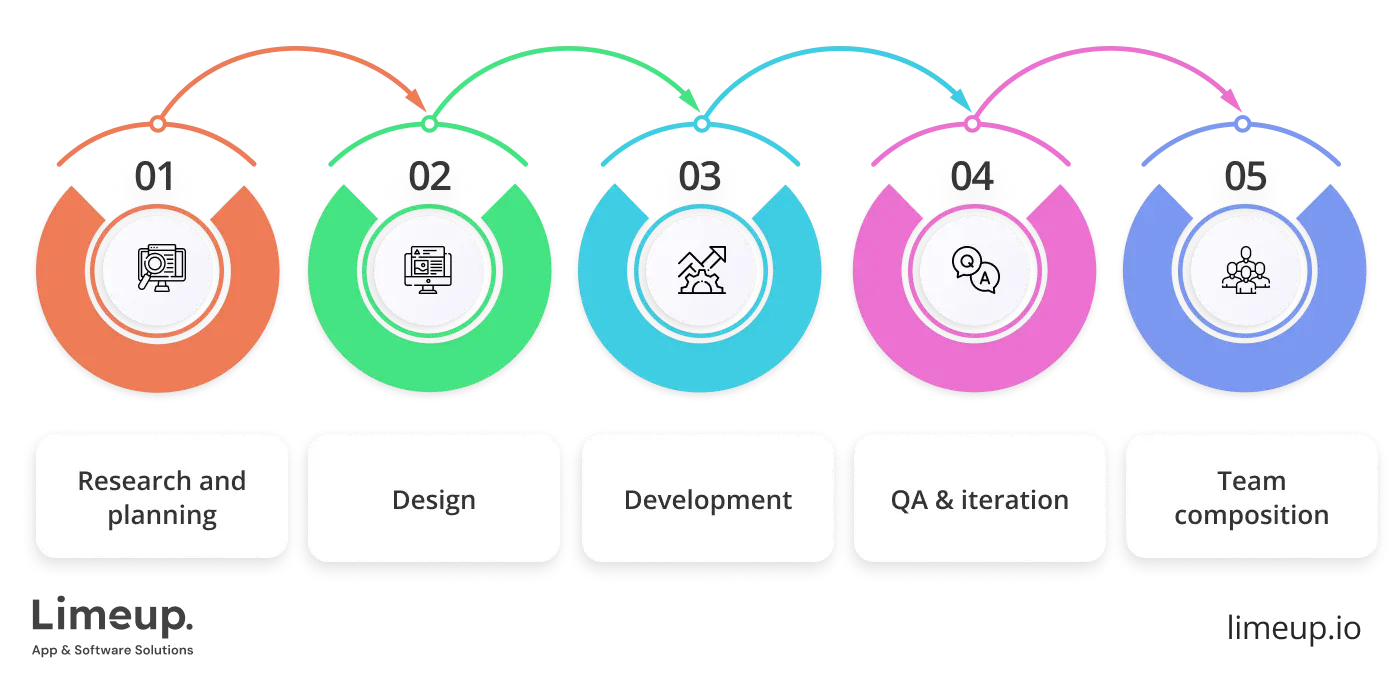
- Research and planning (1–4 weeks) is aimed at defining if you will fit the industry state, features scope, various analyses and other moments we have considered in the how-to part of this material. Here, you will also determine your UVP (Unique Value Proposition), outline what needs to be done.
-
Design (2–6 weeks) stands for wireframing, prototyping, mapping up user journey, their personas, branding, etc. Designers in your team will work with Figma or Adobe XD to make clickable prototypes so that you can edit them before they go live, defining visual components, types.
-
Development (6–26 weeks) which our experts are likely to put simply, takes the longest as your coders manually write the lines, and if you are going solo on this tech trip, you need even more time. During this phase, you will code basic features like log on, dashboard, and the one we have considered above.
Also, you need to take care of your subscription tools, assing systems that enable paying and billing, making purchases and store the history of payments (it is usually an intergration which is also a part of the building process).
The focused system requires less time if you cooperate with IT solutions companies, as well as you may face some challenges related to fixing bugs and adapting to ever-eovlivng needs of your customers and markets.
-
Quality assurance and iteration (3–6 weeks & ongoing) as a part of SaaS product development services is preferable to be included in the timeframe as you need to ensure your solution works across various devices, and other moments we have considered in the material above.
You noticed we write “ongoing” which literally means there is no defined data for you to slow down as your clients will leave feedback about nuances that need to be shaped, scaling infrastructure, optimizing and so on.
-
Team composition (up to 1 week) is optional if you do not want to handle all the aspects we listed on your own, and you need to find programmers, designers, business analysts, UI/UX experts, and others according to your needs.
To put it simply, the more experienced specialists are involved, the faster you will build this product.
The final thought is that the timeline depends on your requirements and capabilities, as well as project complexity, when a complex ERP can not be built in one day just like Rome in that idiom. For now, you know not only how to make a SaaS product but also what time you will dedicate to the creation of your dream platform.
To add more concrete information, we will dive deeper into current tendencies that bring more value to businesses and are worth being integrated.
Latest trends in SaaS based product development
Owners who care about their businesses 100% want to maintain their competitiveness, foster growth in revenue, build long-term success and survive in cut-throat markets, and the essential part of being like this is about knowing what tendencies to follow.

Therefore, you will learn about trends that you can implement for more customer engagement, cost reduction, automation, and enhanced security. Let’s delve deeper into details:
-
AI and Machine Learning integration. AI-powered features are not rocket science anymore as it is evolving with the appearance of Chat GPT and other helpers, allowing companies to develop a SaaS product that improves their workflows, analytics and decision-making process, and more.
According to the latest research from McKinsey, 92% of firms are going to invest in Artificial Intelligence over the next three years. From our perspective as a software development company, it is all owing to beneficial moments like optimization.
-
Microservices architecture. Considering this adoption, our specialists and coders noticed that this style of architecture brings more independence for components and makes the scalability more effective, as you do not need to take care of the whole system at once.
It is also about ongoing maintenance and support, as we noted that development and going live is not the end of your tech journey, and microservices enable you to upgrade or fix specific problems.
-
Increased focus on cybersecurity. On-rise attacks on businesses do not let anyone have a quiet workday, so trending tools are in demand, offering better protection from unauthorized access with real-time monitoring and AI-based (referring to the previous point) analysis to prevent vulnerabilities.
For instance, a fintech organization that stores sensitive personal information needs to invest in cutting-edge security technologies like blockchain to add an extra layer of protection, as well as use threat detection.
-
Personalization and customer experience. This standpoint is the future of the SaaS industry as every market takes on user experience as a core value and you are fighting for customers and their attention in the first place. How can it be implemented? — through user interfaces that cater to their needs, tailored communication style, and so on.
There is also a strategy called “dynamic personalization,” when you adapt to what end-users are browsing through and offer a related experience.
Following the emerging and time-proven trends our experts determined in this material, you will be able to remain at the leading position in your niche and make more out of the capabilities offered by SaaS products.
Why choose Limeup for your SaaS development needs?
For now, you are aware of investing heavily in such a technology that can bring you more revenue and stability in ever-evolving markets, as well as lower barriers to entry and stronger relationships with your customers.
If you would like to simplify the process of creating your own SaaS solution, consider contacting Limeup. With us, you will receive a complete validation of your idea, understanding of the competitive industry landscape, a strategy that suits you, go-to-market ability, and comprehensive design and development.
Let’s team up to create your software product to generate more income and reach new heights in the most cut-throat niches.

